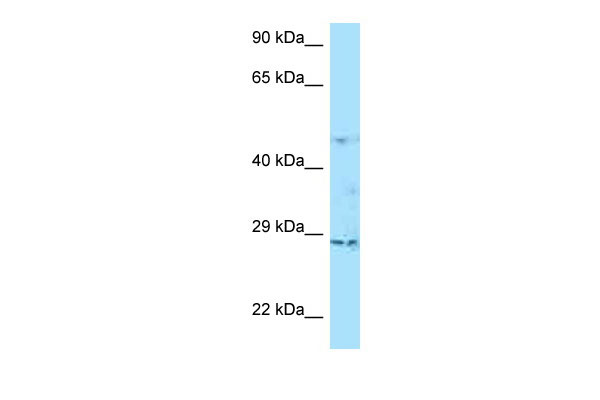TNFAIP6 antibody - C-terminal region
Rabbit Polyclonal Antibody
- 产品详情
- 实验流程
Application
| WB |
|---|---|
| Primary Accession | P98066 |
| Other Accession | NM_007115, NP_009046 |
| Reactivity | Human, Mouse, Rat, Rabbit, Dog, Guinea Pig, Horse, Bovine |
| Predicted | Mouse, Dog, Bovine |
| Host | Rabbit |
| Clonality | Polyclonal |
| Calculated MW | 31203 Da |
| Gene ID | 7130 |
|---|---|
| Alias Symbol | TSG-6, TSG6 |
| Other Names | Tumor necrosis factor-inducible gene 6 protein, Hyaluronate-binding protein, TNF-stimulated gene 6 protein, TSG-6, Tumor necrosis factor alpha-induced protein 6, TNF alpha-induced protein 6, TNFAIP6, TSG6 |
| Format | Liquid. Purified antibody supplied in 1x PBS buffer with 0.09% (w/v) sodium azide and 2% sucrose. |
| Reconstitution & Storage | Add 50 ul of distilled water. Final anti-TNFAIP6 antibody concentration is 1 mg/ml in PBS buffer with 2% sucrose. For longer periods of storage, store at 20°C. Avoid repeat freeze-thaw cycles. |
| Precautions | TNFAIP6 antibody - C-terminal region is for research use only and not for use in diagnostic or therapeutic procedures. |
| Name | TNFAIP6 |
|---|---|
| Synonyms | TSG6 |
| Function | Major regulator of extracellular matrix organization during tissue remodeling (PubMed:15917224, PubMed:18042364, PubMed:26823460). Catalyzes the transfer of a heavy chain (HC) from inter-alpha-inhibitor (I-alpha-I) complex to hyaluronan. Cleaves the ester bond between the C-terminus of the HC and GalNAc residue of the chondroitin sulfate chain in I-alpha-I complex followed by transesterification of the HC to hyaluronan. In the process, potentiates the antiprotease function of I- alpha-I complex through release of free bikunin (PubMed:15917224, PubMed:16873769, PubMed:20463016). Acts as a catalyst in the formation of hyaluronan-HC oligomers and hyaluronan-rich matrix surrounding the cumulus cell-oocyte complex, a necessary step for oocyte fertilization (PubMed:26468290). Assembles hyaluronan in pericellular matrices that serve as platforms for receptor clustering and signaling. Enables binding of hyaluronan deposited on the surface of macrophages to LYVE1 on lymphatic endothelium and facilitates macrophage extravasation. Alters hyaluronan binding to functionally latent CD44 on vascular endothelium, switching CD44 into an active state that supports leukocyte rolling (PubMed:15060082, PubMed:26823460). Modulates the interaction of chemokines with extracellular matrix components and proteoglycans on endothelial cell surface, likely preventing chemokine gradient formation (PubMed:27044744). In a negative feedback mechanism, may limit excessive neutrophil recruitment at inflammatory sites by antagonizing the association of CXCL8 with glycosaminoglycans on vascular endothelium (PubMed:24501198). Has a role in osteogenesis and bone remodeling. Inhibits BMP2-dependent differentiation of mesenchymal stem cell to osteoblasts (PubMed:16771708, PubMed:18586671). Protects against bone erosion during inflammation by inhibiting TNFSF11/RANKL- dependent osteoclast activation (PubMed:18586671). |
| Cellular Location | Secreted. |
| Tissue Location | Expressed in airway epithelium and submucosal gland (at protein level). Colocalizes with bikunin at the ciliary border Present in bronchoalveolar lavage fluid (at protein level) (PubMed:16873769). Expressed in mesenchymal stem cells (PubMed:16771708). Found in the synovial fluid of patients with rheumatoid arthritis. |
Research Areas
For Research Use Only. Not For Use In Diagnostic Procedures.
Application Protocols
Provided below are standard protocols that you may find useful for product applications.
REFERENCES
Lee T.H.,et al.J. Cell Biol. 116:545-557(1992).
Nentwich H.A.,et al.J. Biol. Chem. 277:15354-15362(2002).
Hillier L.W.,et al.Nature 434:724-731(2005).
Mural R.J.,et al.Submitted (SEP-2005) to the EMBL/GenBank/DDBJ databases.
Wisniewski H.-G.,et al.Biochemistry 33:7423-7429(1994).
终于等到您。ABCEPTA(百远生物)抗体产品。
点击下方“我要评价 ”按钮提交您的反馈信息,您的反馈和评价是我们最宝贵的财富之一,
我们将在1-3个工作日内处理您的反馈信息。
如有疑问,联系:0512-88856768 tech-china@abcepta.com.























 癌症的基本特征包括细胞增殖、血管生成、迁移、凋亡逃避机制和细胞永生等。找到癌症发生过程中这些通路的关键标记物和对应的抗体用于检测至关重要。
癌症的基本特征包括细胞增殖、血管生成、迁移、凋亡逃避机制和细胞永生等。找到癌症发生过程中这些通路的关键标记物和对应的抗体用于检测至关重要。 为您推荐一个泛素化位点预测神器——泛素化分析工具,可以为您的蛋白的泛素化位点作出预测和评分。
为您推荐一个泛素化位点预测神器——泛素化分析工具,可以为您的蛋白的泛素化位点作出预测和评分。 细胞自噬受体图形绘图工具为你的蛋白的细胞受体结合位点作出预测和评分,识别结合到自噬通路中的蛋白是非常重要的,便于让我们理解自噬在正常生理、病理过程中的作用,如发育、细胞分化、神经退化性疾病、压力条件下、感染和癌症。
细胞自噬受体图形绘图工具为你的蛋白的细胞受体结合位点作出预测和评分,识别结合到自噬通路中的蛋白是非常重要的,便于让我们理解自噬在正常生理、病理过程中的作用,如发育、细胞分化、神经退化性疾病、压力条件下、感染和癌症。






